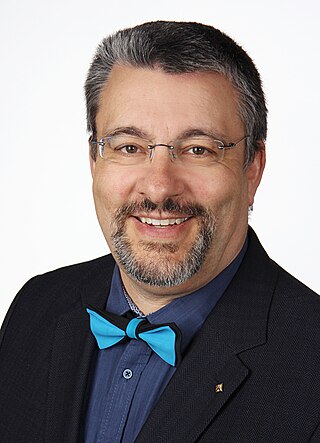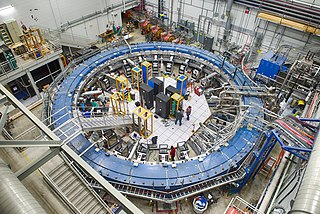
Super-Kamiokande is a neutrino observatory located under Mount Ikeno near the city of Hida, Gifu Prefecture, Japan. It is located 1,000 m (3,300 ft) underground in the Mozumi Mine in Hida's Kamioka area. The observatory was designed to detect high-energy neutrinos, to search for proton decay, study solar and atmospheric neutrinos, and keep watch for supernovae in the Milky Way Galaxy.

Data acquisition is the process of sampling signals that measure real-world physical conditions and converting the resulting samples into digital numeric values that can be manipulated by a computer. Data acquisition systems, abbreviated by the acronyms DAS,DAQ, or DAU, typically convert analog waveforms into digital values for processing. The components of data acquisition systems include:

The Compact Muon Solenoid (CMS) experiment is one of two large general-purpose particle physics detectors built on the Large Hadron Collider (LHC) at CERN in Switzerland and France. The goal of the CMS experiment is to investigate a wide range of physics, including the search for the Higgs boson, extra dimensions, and particles that could make up dark matter.

ATLAS is the largest general-purpose particle detector experiment at the Large Hadron Collider (LHC), a particle accelerator at CERN in Switzerland. The experiment is designed to take advantage of the unprecedented energy available at the LHC and observe phenomena that involve highly massive particles which were not observable using earlier lower-energy accelerators. ATLAS was one of the two LHC experiments involved in the discovery of the Higgs boson in July 2012. It was also designed to search for evidence of theories of particle physics beyond the Standard Model.

TRIUMF is Canada's national particle accelerator centre. It is considered Canada's premier physics laboratory, and consistently regarded as one of the world's leading subatomic physics research centres. Owned and operated by a consortium of universities, it is on the south campus of one of its founding members, the University of British Columbia in Vancouver, British Columbia, Canada. It houses the world's largest normal conducting cyclotron, a source of 520 MeV protons, which was named an IEEE Milestone in 2010. Its accelerator-focused activities involve particle physics, nuclear physics, nuclear medicine, materials science, and detector and accelerator development.
In nuclear physics, an energy amplifier is a novel type of nuclear power reactor, a subcritical reactor, in which an energetic particle beam is used to stimulate a reaction, which in turn releases enough energy to power the particle accelerator and leave an energy profit for power generation. The concept has more recently been referred to as an accelerator-driven system (ADS) or accelerator-driven sub-critical reactor.

Paul Hermann Scherrer was a Swiss physicist. Born in St. Gallen, Switzerland, he studied at Göttingen, Germany, before becoming a lecturer there. Later, Scherrer became head of the Department of Physics at ETH Zurich.

ROOT is an object-oriented computer program and library developed by CERN. It was originally designed for particle physics data analysis and contains several features specific to the field, but it is also used in other applications such as astronomy and data mining. The latest minor release is 6.28, as of 2023-02-03.

The Paul Scherrer Institute (PSI) is a multi-disciplinary research institute for natural and engineering sciences in Switzerland. It is located in the Canton of Aargau in the municipalities Villigen and Würenlingen on either side of the River Aare, and covers an area over 35 hectares in size. Like ETH Zurich and EPFL, PSI belongs to the Swiss Federal Institutes of Technology Domain of the Swiss Confederation. The PSI employs around 2,100 people. It conducts basic and applied research in the fields of matter and materials, human health, and energy and the environment. About 37% of PSI's research activities focus on material sciences, 24% on life sciences, 19% on general energy, 11% on nuclear energy and safety, and 9% on particle physics.

Muon spin spectroscopy, also known as µSR, is an experimental technique based on the implantation of spin-polarized muons in matter and on the detection of the influence of the atomic, molecular or crystalline surroundings on their spin motion. The motion of the muon spin is due to the magnetic field experienced by the particle and may provide information on its local environment in a very similar way to other magnetic resonance techniques, such as electron spin resonance and, more closely, nuclear magnetic resonance (NMR).

ALICE is one of nine detector experiments at the Large Hadron Collider at CERN. The other eight are: ATLAS, CMS, TOTEM, LHCb, LHCf, MoEDAL, FASER and SND@LHC.

The DØ experiment was a worldwide collaboration of scientists conducting research on the fundamental nature of matter. DØ was one of two major experiments located at the Tevatron Collider at Fermilab in Batavia, Illinois. The Tevatron was the world's highest-energy accelerator from 1983 until 2009, when its energy was surpassed by the Large Hadron Collider. The DØ experiment stopped taking data in 2011, when the Tevatron shut down, but data analysis is still ongoing. The DØ detector is preserved in Fermilab's DØ Assembly Building as part of a historical exhibit for public tours.
The neutron electric dipole moment (nEDM), denoted dn, is a measure for the distribution of positive and negative charge inside the neutron. A nonzero electric dipole moment can only exist if the centers of the negative and positive charge distribution inside the particle do not coincide. So far, no neutron EDM has been found. The current best measured limit for dn is (0.0±1.1)×10−26 e⋅cm.

A neutron research facility is most commonly a big laboratory operating a large-scale neutron source that provides thermal neutrons to a suite of research instruments. The neutron source usually is a research reactor or a spallation source. In some cases, a smaller facility will provide high energy neutrons using existing neutron generator technologies.
FASTBUS is a computer bus standard, originally intended to replace Computer Automated Measurement and Control (CAMAC) in high-speed, large-scale data acquisition. It is also a modular crate electronics standard commonly used in data acquisition systems in particle detectors.

The NA62 experiment is a fixed-target particle physics experiment in the North Area of the SPS accelerator at CERN. The experiment was approved in February 2007. Data taking began in 2015, and the experiment is expected to become the first in the world to probe the decays of the charged kaon with probabilities down to 10−12. The experiment's spokesperson is Cristina Lazzeroni. The collaboration involves 333 individuals from 30 institutions and 13 countries around the world.

In 2011, the OPERA experiment mistakenly observed neutrinos appearing to travel faster than light. Even before the source of the error was discovered, the result was considered anomalous because speeds higher than that of light in vacuum are generally thought to violate special relativity, a cornerstone of the modern understanding of physics for over a century.

Stefan Ritt is a German physicist and head of the muon physics group at the Paul Scherrer Institute, Aargau, Switzerland. He is member of the MEG experiment and co-spokesperson of the Mu3e experiment. He is best known for the development of the DRS4 Switched Capacitor Array Chip, as primary author of the MIDAS Data Acquisition System and as author of the ELOG Electronic Logbook. He is co-author of two patents related to Switched Capacitor Array Circuits and their calibration.

Muon g − 2 is a particle physics experiment at Fermilab to measure the anomalous magnetic dipole moment of a muon to a precision of 0.14 ppm, which is a sensitive test of the Standard Model. It might also provide evidence of the existence of new particles.
Mu3e is a particle physics experiment at the Paul Scherrer Institute, searching for decays of anti-muons (Mu) to an electron and two positrons (3e). This decay is extremely unlikely in the Standard Model of particle physics, as it changes the lepton number. Several new theories, especially supersymmetric ones, predict a much more frequent decay. Searching for this decay allows a test of these theories, even if they cannot be tested directly in other experiments like at the LHC. It has also been shown the experiment is sensitive to probe new light dark sector particles such as dark photon.















